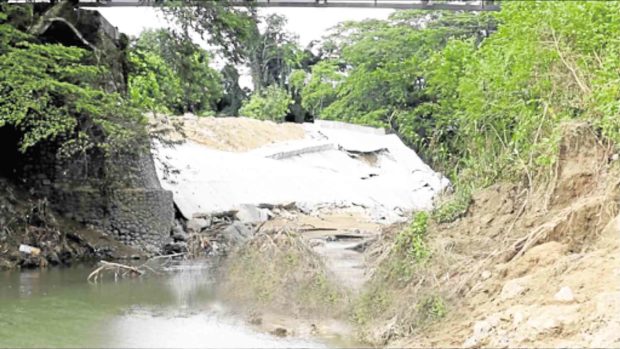Wasteful projects traced to kickbacks

COLLAPSE A week after the Laoag flood control project was reported completed on July 11, 2018, it “collapsed like a fallen curtain,” according to a former Ilocos Norte board member. —PHOTO COURTESY OF SEN. PANFILO LACSON’S OFFICE
(Second of three parts)
Tongues have been wagging about a notorious Ilocos Norte official nicknamed “Engineer Forty,” who, as the story goes, routinely pockets a 40-percent cut of the cost of infrastructure projects in the district.
It’s local lore that seems steeped in reality if one considers what happened in a P10-million flood control project on the Laoag river basin tributary that runs through the villages of Bacsil, Lataag and San Mateo in Laoag City.
Barely a week after the project was completed in July 2018, the concrete structure crumbled, leaving officials red-faced and residents angry.
Pork in the budget
The incident, according to Sen. Panfilo Lacson, is one of the new manifestations of pork in the budget — where contractors shortchange taxpayers by using low-grade materials for infrastructure projects, while gifting agency officials and lawmakers with huge commissions in exchange for the contracts.
Pork, public money used to finance projects proposed by lawmakers, is a source of kickbacks.
But over the years, legislators in cahoots with agencies and contractors have become creative in larding the government’s budget, according to Lacson, who earlier exposed the insertion of multibillion-peso allocations in the districts of favored legislators, wastage of P583.5 billion in discontinued or shelved projects, and P74.6 billion in road projects marred by right of way issues.
At present, Lacson said, the going rate for kickbacks is “10 percent [of the project cost] to the legislator, and 5 percent to the agency.”
It’s the contractor who would shell out the money, often in the millions of pesos, to satisfy the politicians, he told Inquirer editors and reporters during a briefing in December last year.
So how do contractors make money?
“Substandard materials,” Lacson replied.
Public money wasted
This was precisely the case with the Laoag flood control project, which began construction on Feb. 12, 2018, and was completed on July 11, 2018, Lacson said.
“One week after construction, it caved in,” he said.
Former Ilocos Norte Board Member Melvin de la Cuesta, who inspected and photographed the site, said the dike “collapsed like a fallen curtain.”
“Clearly, the project is substandard and it needs investigation by appropriate agency. Public money is wasted through anomalous projects,” De la Cuesta said in a Facebook post on Aug. 30, 2018.
Contacted by the Inquirer on Monday, De la Cuesta said he found that no steel bars were used to build the dike, making the foundation weak.
“The cement was thin,” he added.
‘Soil was loose’
De la Cuesta recalled the controversy the debacle stirred among officials of the Ilocos Norte provincial government and the investigation that followed.
“The excuse of engineers was that the soil was loose,” he said.
The contractor, Katha Builders and Supplies, eventually bowed to public pressure and reconstructed the dike, according to De la Cuesta. It is now back in operation.
According to the records, the Laoag project was given P9,503,768.23 in the General Appropriations Act of 2018, with the Department of Public Works and Highways (DPWH) district engineering office as implementing agency.
Katha Builders is one of the top contractors of the DPWH under the Duterte administration.
According to data compiled by the Philippine Center for Investigative Journalism, the company based in Santa Maria, Bulacan province, cornered DPWH contracts valued at P235.5 million from July 2016 to December 2017.
The Inquirer tried but could not reach Katha on its listed contact numbers.
65-35 sharing
Lacson said pork, by definition, was a “postenactment” practice, meaning lawmakers would insert funds into the budget law after it had been passed.
But the practice stopped in the aftermath of Supreme Court decisions striking down the pork barrel system and its iterations, including the Priority Development Assistance Fund, as well as graft and plunder cases sparked by the P10-billion pork scam involving businesswoman Janet Lim-Napoles.
In the case of the Napoles scam, Lacson said it involved mostly soft projects, referring to social welfare programs.
“So with Napoles, 65 percent went to the legislator, while Napoles got 35 percent. The costs were also shouldered by Napoles, while 65 percent went cleanly to the legislator. Napoles would get some from the remaining 35 percent to cover the operation,” he said.
These days, Lacson said pork insertions would happen even before the President submitted the proposed budget, or the National Expenditure Program (NEP), to Congress.
“Sometimes the congressman or the agency could get an advance from the contractor before the budget law was passed,” he said.
The official reason is “exigency,” he said. “If you wait for the passage of the GAA (General Appropriations Act) before bidding, then it would take too long, because our bidding process can be quite lengthy,” he said.
Laguna bridge
On Jan. 10, Lacson called attention to an Inquirer story about a portion of a bridge under construction that collapsed in Pakil, Laguna province.
The DPWH district engineer blamed the contractor, St. Gerrard Construction General Contractor and Development Corp., of Pasig City, saying the lack of scaffolding and other support systems caused the structure to collapse when the workers poured concrete.
Lacson lamented on Twitter: “If this happened in other jurisdictions, government agents would be knocking on some people’s doors.”